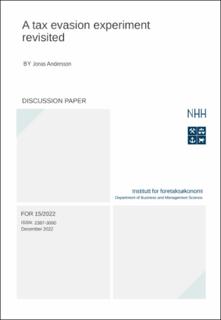A tax evasion experiment revisited
Working paper

Åpne
Permanent lenke
https://hdl.handle.net/11250/3041327Utgivelsesdato
2022-12-30Metadata
Vis full innførselSamlinger
- Discussion papers (FOR) [566]
Sammendrag
In this paper the experimental data collected by Masclet, Montmarquette, and Viennot-Briot (2019a) is revisited in order to study some aspects of the drivers of the declaration rate, not studied in the authors’ article. By using a zero-one inflated beta regression model, a more detailed analysis of the special values, zero declaration and full declaration, is enabled. It turns out that some of the drivers of the declaration rate is affecting the three parts of the declaration rate distribution, the zero declarers, the full declarers and the intermediate declarers, differently. It is found that the effect of tax payers’ monitoring, i.e., their knowledge about other tax payers’ evasion, increases the probability to declare zero. Among the individuals declaring a part of their income, the effect is significantly positive; they declare more. Another result is that, for the average experiment participant, both the probability to fully declare or declare nothing of the income is increasing as the experiment progresses.